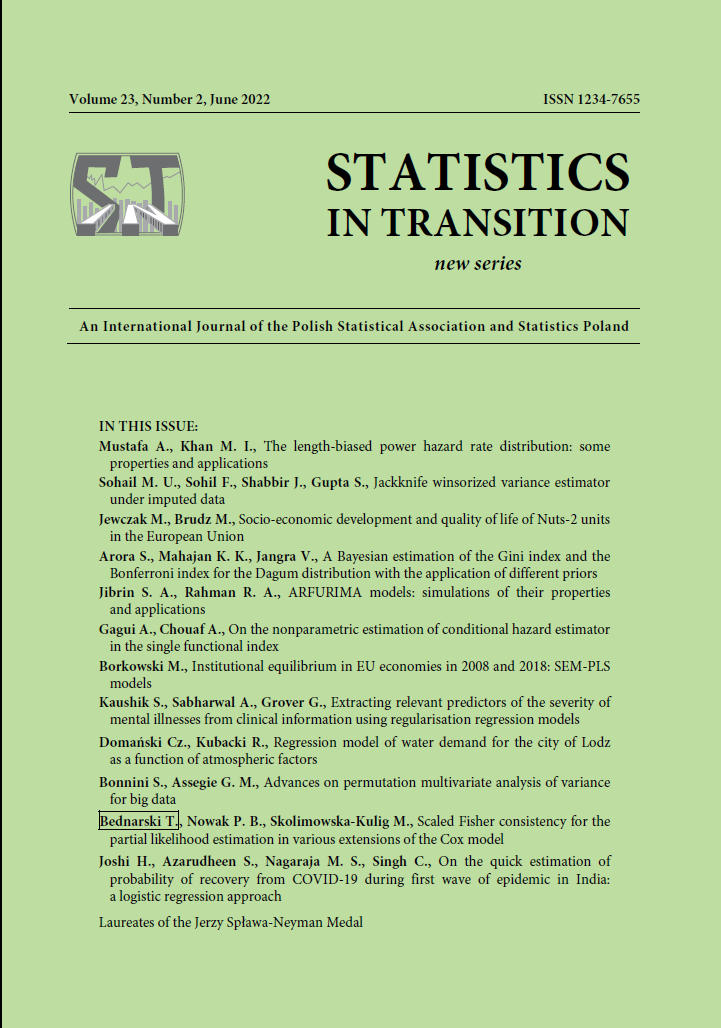© Hemlata Joshi, S. Azarudheen, M. S. Nagaraja, Singh Chandraketu. Article available under the CC BY-SA 4.0
![]()
ARTICLE
ABSTRACT
The COVID-19 pandemic has recently become a threat all across the globe with the rising cases every day and many countries experiencing its outbreak. According to the WHO, the virus is capable of spreading at an exponential rate across countries, and India is now one of the worst-affected country in the world. Researchers all around the world are racing to come up with a cure or treatment for COVID-19, and this is creating extreme pressure on the policy makers and epidemiologists. However, in India the recovery rate has been far better than in other countries, and is steadily improving. Still in such a difficult situation with no effective medicine, it is essential to know if a patient with the COVID-19 is going to recover or die. To meet this end, a model has been developed in this article to estimate the probability of a recovery of a patient based on the demographic characteristics. The study used data published by the Ministry of Health and Family Welfare of India for the empirical analysis.
KEYWORDS
COVID-19, epidemic, coronavirus disease, recovery estimation, logistic regression, logit analysis
REFERENCES
Anastassopoulou, C., Russo, L., Tsakris, A. and Siettos, C., (2020). Data-based analysis, modelling and forecasting of the COVID-19 outbreak, PLOS ONE, 15(3), e0230405. https://doi.org/10.1371/journal.pone.0230405.
Backhaus, K., Erichson, B., Plinke, W. and Weiber, R., (2000). Multivariate analysenmethoden, Berlin: Springer.
Chen, Yi C., Lu, P. E., Chang, C. S. and Liu, T. H., (2020). A Time-dependent SIR model for COVID-19 with Undetectable Infected Persons, http://gibbs1.ee.nthu.edu.tw/A Time Dependent SIR Model For Covid 19.pdf.
Chatterjee, S. and Hadi, Ali S., (2006) Regression analysis by example. John Wiley & Sons, Inc., Hoboken, New Jersey.
Corman, V. M., Landt, O., Kaiser, M., Molenkamp, R., Meijer, A., Chu, D. K., Bleicker, T., Brunink, S., Schneider, J. and Schmidt, M. L., (2020). Detection of 2019 novel coronavirus (2019-ncov) by realtime rt-pcr, Euro surveillance, 25(3), 2000045.
Ferguson, N. M., Laydon, D., Nedjati-Gilani, G., Imai, N., Ainslie, K., Baguelin, M., Bhatia, S., Boonyasiri, A., Cucunuba, Z., Cuomo-Dannenburg, G., Dighe, A. Dorigatti, I., Fu, H., Gaythorpe, K., Green, W., Hamlet, A., Hinsley, W., Okell, L. C., Elsland, S. V., Thompson, H., Verity, R., Volz, E., Wang H., Wang, Y., Walker, P. Gt., Walters, C., Winskill, P., Whittaker, C., Donnelly, C. A., Riley, S. and Ghani, A. C., (2020). Report 9: Impact of non-pharmaceutical interventions (NPIs) to reduce COVID-19 mortality and healthcare demand, Imperial College COVID-19 Response Team.
Gamero, J., Tamayo, J. A. and Martinez-Roman J. A., (2020). Forecast of the evolution of the contagious disease caused by novel corona virus (2019-ncov) in China, arXiv preprint ar Xiv: 2002, 04739.
Huang, C., Wang, Y., Li, X., Ren, L., Zhao, J., Hu, Y., Zhang, L., Fan, G., Xu, J. and Gu, X., (2020). Clinical features of patients infected with 2019 novel coronavirus in Wuhan, China, The Lancet, 395(10223), pp. 497?506.
Hosmer Dw, Lemeshow S., (2000). Applied Logistic Regression (2nd Edition), New York, NY: John Wiley & Sons;.
Nikolay K., Anton I. and Asen R., (2020). On the half–logistic model with ”polynomial variable transfer”. Application to approximate the specific ”data corona virus”. International Journal of Differential Equations and Applications, 19(1), pp. 45?61.
Nikolay K., Anton I. and Asen R. (2020). On the Verhulst growth model with polynomial variable transfer. Some applications. International Journal of Differential Equations and Applications, 19(1), pp. 15-32.
Maksym Z., Roman O. B., Yuliia P., Maksim I. and Irakli P., (2020). Mathematical model building for COVID-19 diseases data in European Countries. IDDM’2020: 3rd International Conference on Informatics & Data-Driven Medicine, November 19–21, 2020, Växjö, Sweden, Session 1: Artificial intelligence, CEUR Workshop Proceedings.
Rao Srinivasa A., S. R., Krantz S., G., Kurien T. and Bhat R., (2020). Model based retrospective estimates for COVID-19 or coronavirus in India: continued efforts required to contain the virus spread. Current Science, 118(7), pp. 1023-1025.
R Core Team, (2020). R: A language and environment for statistical computing. R Foundation for Statistical Computing, Vienna, Austria, URL https://www.Rproject. org/.
Rothe, C., Schunk, M., Sothmann, P., Bretzel, G., Froeschl, G., Wallrauch, C., Zimmer, T., Thiel, V., Janke C. and Guggemos, W., (2020). Transmission of 2019-ncov infection from an asymptomatic contact in Germany. New England Journal of Medicine, 382(10), pp. 970-971.
Singh, B. P., Singh, G., (2020). Modeling Tempo of COVID-19 Pandemic in India and Significance of Lockdown, https://doi.org/10.1002/pa.2257.
Singh, B. P., (2020). Forecasting Novel Corona Positive Cases in India using Truncated Information: A Mathematical Approach, medRxiv preprint, doi: https://doi.org/10.1101/2020.04.29.20085175.
Singh, R., Adhikari, R., (2020). Age-structured impact of social distancing on the COVID-19 epidemic in India, arXiv: 2003, 12055.
Singhal, T., (2020). A review of coronavirus disease-2019 (COVID-19). The Indian Journal of Pediatrics, pp. 1-6.
World Health Organization, (2020). Updated WHO advice for international traffic in relation to the outbreak of the novel coronavirus 2019-nCoV, Available at: https://www.who.int/ith/2020-24-01-outbreak-of-Pneumonia-caused-by-newcoronavirus/ en/ (accessed January 2020).
World Health Organization, (2020). Coronavirus disease (COVID-19) Weekly Epidemiological Update and Weekly Operational Update, Available at: https://www.who.int/emergencies/diseases/novel-coronavirus-2019/situationreports (accessed March 2020).
